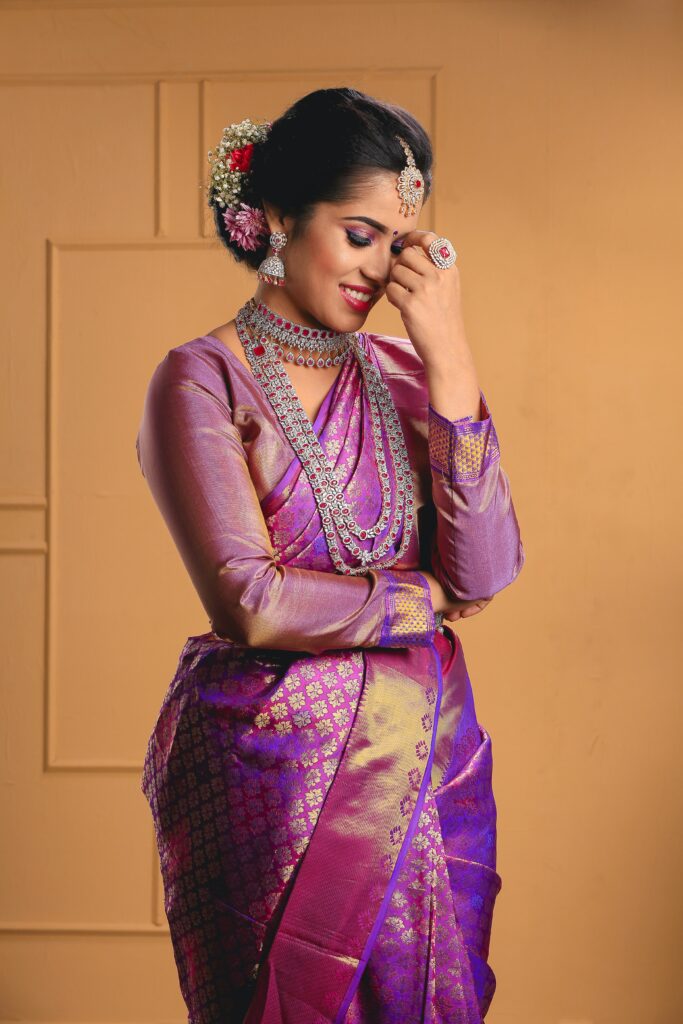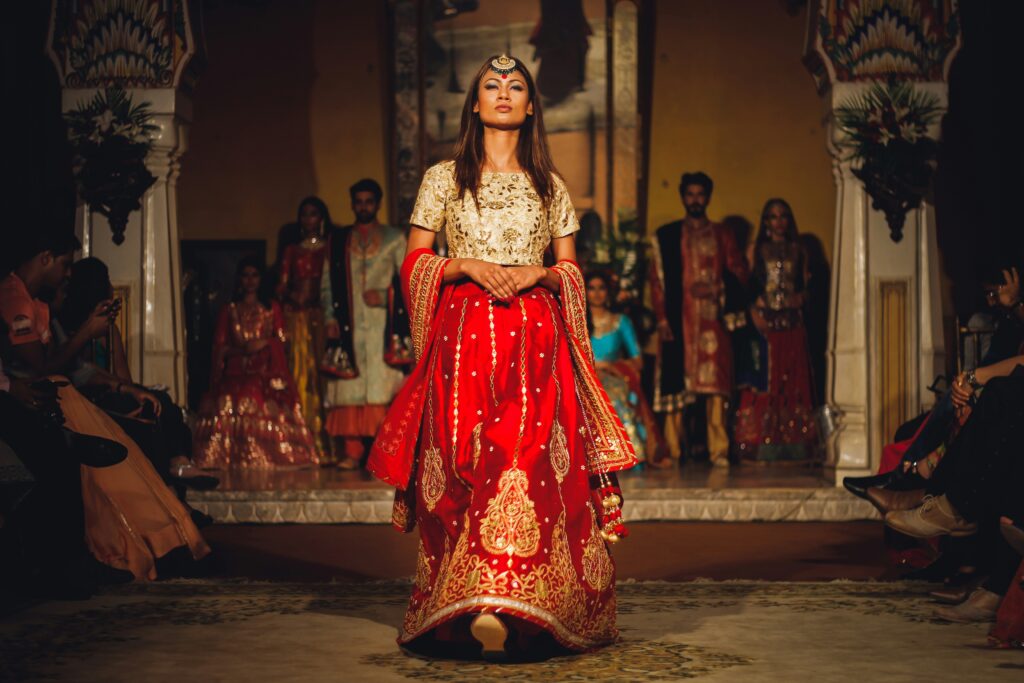
Table of Contents
Indian fashion and textile industries
The Indian fashion and textile industries hold immense cultural significance and boast a rich history that has shaped the nation’s global fashion identity. With its exceptional craftsmanship, traditional textiles, and innovative designs, India has always been at the of creativity and style. In this article, we will delve into the latest trends in the Indian fashion and textile industries with distinctive elements of Indian fashion, the technological advancements in the textile industry, emerging trends, and the future outlook of these thriving sectors.
Distinctive Elements of Indian Fashion
India is renowned for its opulent heritage and traditional craftsmanship, which finds expression in its textiles. The timeless beauty of handwoven fabrics narrates stories of exquisite artistry. Meticulously crafted using ancestral techniques passed down through generations, these fabrics celebrate creativity and showcase elaborate embroidery styles like Lucknowi Chikan and Zardozi, as well as the exquisite embellishments of Zari and Kundan work.
In recent years, there has been a revival of indigenous dyeing and printing techniques. Art forms like Bandhani, Ajrakh, and Kalamkari have regained popularity as designers and artisans recognize the importance of preserving these age-old techniques. These methods not only add a unique charm to garments but also promote sustainability by utilizing natural dyes and organic materials.

The fusion of traditional and contemporary styles is another distinctive feature of Indian fashion. Designers are constantly discovering innovative ways to adapt traditional garments to suit modern preferences. The classic saree, for instance, has undergone a contemporary transformation with designers experimenting with different drapes, prints, and fabrics. Modern designs also incorporate traditional motifs and patterns, resulting in a harmonious blend of the old and the new. Additionally, fusion silhouettes and patterns are gaining popularity, allowing for a creative interplay between traditional craftsmanship and contemporary aesthetics.


Sustainability practices are gaining momentum in the Indian fashion industry. Designers and brands are actively promoting the use of eco-friendly fabrics and materials. Organic cotton, bamboo, and hemp have emerged as popular alternatives to conventional textiles. The revival of traditional sustainable practices, such as handloom weaving and natural dyeing, contributes to a more sustainable fashion ecosystem. Furthermore, there is a growing emphasis on ethical production and fair trade, ensuring fair treatment and proper wages for workers behind the scenes.
Technological Advancements in the Indian Textile Industry
The Indian textile industry is currently undergoing a technological revolution that has transformed fabric manufacturing and design. Automation and digitalization have played a vital role in streamlining the manufacturing process. With cutting-edge technology, the industry has witnessed significant improvements in efficiency and productivity. Automated machinery is now employed for various tasks ranging from spinning and weaving to dyeing and finishing. This not only reduces human error but also expedites production, making it more cost-effective.
The integration of electronics into textiles has given rise to the concept of smart textiles and wearable technology. Fabrics are now designed to incorporate electronic components, enabling functionalities such as health monitoring and interactive experiences. Wearable technology, including smartwatches and fitness trackers, has gained popularity by seamlessly blending fashion with our digital lives. Researchers and designers are also exploring sustainable smart textiles, which combine technology with eco-friendly materials to create innovative and environmentally conscious solutions.
Textile printing and finishing have witnessed significant innovation in the Indian textile industry. Digital printing has revolutionized textile design, allowing for intricate patterns and vibrant colors to be achieved with precision. This technology offers endless possibilities for designers to experiment and create unique textiles. Sustainable and customized printing solutions are also on the rise, enabling brands to minimize waste and create personalized products. Advancements in fabric finishing techniques, such as bio-finishing and anti-microbial treatments, have further enhanced textile functionality and durability.
Note: “Discover radiant skin: Read our blog on ‘Top 10 insider beauty tips for healthy glowing skin’ now!”
Emerging Fashion Trends in India
In recent years, India has witnessed the rise of sustainable and slow fashion movements. As consumers become more conscious of their environmental impact, there has been a shift towards prioritizing sustainable and ethical fashion choices. The principles of slow fashion, which emphasize quality over quantity, have gained momentum as consumers embrace the idea of investing in timeless and durable garments. Circular fashion and upcycling initiatives are also being promoted, encouraging the reuse and repurposing of garments to reduce waste.
Bollywood, India’s flourishing film industry, continues to have a significant influence on fashion trends. The glamorous outfits worn by Bollywood stars in movies and red carpet events often set the tone for the latest fashion trends. This influence has been further amplified through social media, as celebrities showcase their fashion choices on platforms like Instagram and Twitter. Fashion enthusiasts look to these celebrities for inspiration and eagerly follow their style trends. As a result, collaborations between celebrities and fashion brands have become increasingly common, capitalizing on the influence and reach of social media.

Another noteworthy trend in the Indian fashion industry is the growing importance of inclusive fashion. The industry is breaking stereotypes and promoting body positivity by featuring diverse body types and embracing individuality. Brands are expanding their size ranges and offering inclusive options to cater to a wider audience. Fashion campaigns now focus on celebrating diversity and challenging traditional beauty standards. This shift towards inclusivity has resonated with consumers, who demand representation and advocate for a more inclusive fashion industry.
Summary
In conclusion, the Indian fashion and textile industries are undergoing significant transformations fueled by a rich heritage, innovative technology, and changing consumer preferences. The revival of traditional craftsmanship, fusion of traditional and contemporary styles, and sustainability practices are driving the industry towards a more conscious and ethical future. Technological advancements in automation, smart textiles, and textile printing are revolutionizing the manufacturing process and allowing for greater creativity. Emerging fashion trends, influenced by Bollywood and social media, are shaping consumer preferences and promoting inclusivity. The Indian fashion and textile industries are poised for growth and are set to make a lasting impact on the global fashion stage.
Note: “Discover radiant skin: Read our blog on ‘8 Powerful Dry Fruits for Glowing Skin’ now!”
FAQs
1. How has the Indian fashion industry evolved over the years?
The Indian fashion industry has come a long way in terms of its global presence and influence. From being primarily known for traditional garments such as sarees and salwar kameez, it has now diversified into diverse segments including Western wear, luxury fashion, and sustainable fashion. Indian designers and brands are increasingly gaining recognition and showcasing their collections at international fashion weeks. Moreover, the industry has witnessed a paradigm shift towards sustainability and inclusivity, reflecting changing consumer preferences.
2. What are some traditional Indian textiles and techniques that are regaining popularity?
Traditional Indian textiles such as Banarasi silk, Chanderi, Kanjeevaram, and Patola are regaining popularity both in India and globally. These luxurious fabrics are known for their intricate weaves, vibrant colors, and opulent designs. Techniques such as tie-dyeing (Bandhani), hand block printing (Ajrakh), and hand embroidery (Zardozi) are also gaining recognition for their craftsmanship and uniqueness.
3. How is sustainability being integrated into the Indian fashion and textile industries?
Sustainability has become a key focus in the Indian fashion and textile industries. Designers and brands are increasingly using eco-friendly fabrics such as organic cotton, bamboo, and hemp. Traditional sustainable practices like handloom weaving, natural dyeing, and zero-waste pattern making are being revived. Additionally, there is a growing emphasis on ethical production practices, fair trade, and ensuring the welfare of artisans and workers.
4. What role does technology play in shaping the future of Indian textiles?
Technology plays a crucial role in shaping the future of Indian textiles. Automation and digitalization have revolutionized the manufacturing process, increasing efficiency and productivity. Smart textiles and wearable technology have opened up new possibilities for integrating electronics into fabrics, creating functional and interactive garments. Digital printing has enabled designers to explore innovative and customized designs, while fabric finishing techniques have improved the functionality and durability of textiles.
5. How is social media influencing fashion trends in India?
Social media has had a profound impact on fashion trends in India. Platforms like Instagram and Twitter have become virtual runways for celebrities and influencers to showcase their style. Consumers look to these platforms for fashion inspiration and follow the latest trends. Additionally, social media has facilitated collaborations between celebrities and fashion brands, providing a wider reach and making fashion more accessible.
Here are some additional reference links that you readers can explore for more insights on Indian fashion and textiles:
- National Institute of Fashion Technology (NIFT):
- Crafts Museum – New Delhi:
- Textile Association of India:
- Vogue India – Fashion News:
- Fashion Revolution India:






